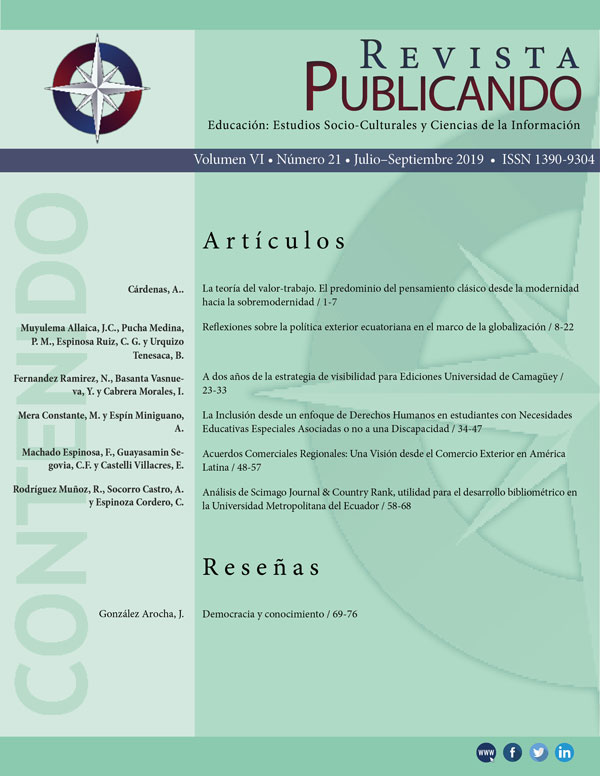Abstract
One of the problems in universities lies in achieving a scientific culture that includes identifying high-impact journals. The wide range of sources led us to reconsider which are the ones that provide the most information in indexed journals of high impact and that influence the positioning of university rankings. The article aims to set guidelines about Scimago Journal & Country Rank and in particular when it refers to Scimago Journal Rank (SJR) that influences the performance of the university. Based on its components and sections, a point of view for universities is offered, and its dissemination and recognition by teachers is proposed. The methodology is based on Bibliometrics and data analysis to present a proposal for SJR disclosure. As a result, the guidelines for the dissemination of the SJR and its inclusion in courses with tools for the writing of scientific articles and indexed journals at the Metropolitan University of Ecuador are presented.
References
Biblioguías (2018). SJR, SCImago Journal & Country Rank: SCImago Journal Rank. Recuperado de: https://biblioguias.biblioteca.deusto.es/c.php?g=515641&p=3525056
Consultas de Educación. (2018). Ranking Universidades de Ecuador. Recuperado de: http://consultaseducacion.com/ranking-universidades-de-ecuador-2018/
Elsevier R & D Solutions. (2015). Case Study Scopus. Recuperado de: https://www.elsevier.com/es-mx/solutions/scopus
Escorcia Otalora, T, A. (2008). El Análisis Bibliométrico como herramienta para el seguimiento de publicaciones Científicas, tesis y trabajos de grado. Trabajo de grado. Pontificia Universidad javeriana. Facultad de Ciencias. Carrera de Microbiología Industrial.
Andrade, V. F., Sierra, A. V. G., & García, A. R. G. (2017). Características editoriales de las revistas electrónicas ecuatorianas indexadas en
Catálogo de Latindex. Revista Publicando, 4(10 (1)), 118-130.
Funes Neira, C., Heredia Farías, C., & Suárez Hernández, V. (2011). Las revistas científicas latinoamericanas en el ISI Web of Science: una opción para académicos e investigadores. Serie Bibliotecología y Gestión de Información, (65), 1-30.
Guerrero-Bote, V. P., & Moya-Anegón, F. (2012). A further step forward in measuring journals”™ scientific prestige: The SJR2 indicator. Journal of informetrics, 6(4), 674-688.
Izquierdo-Egea, P. (2018). Implementando un índice que pondere el impacto de una revista científica en función de su juventud. Arqueología Iberoamericana, 37, 31-39.
Ley orgánica de Educación Superior (2018). Consejo de Educación Superior. Recuperado de http://www.ces.gob.ec/index.php?option=com_phocadownload&view=category&id=11:ley-organica-de-educacion-superior&Itemid=137
Larrea de Granados, E. (2015).El currículo de la Educación Superior desde la complejidad sistémica. Recuperado de http://www.ces.gob.ec/doc/Taller-difusion/SubidoAbril-2015/curriculo_es-sistemico%20-%20e%20larrea.pdf
Manual de procedimientos del sistema de publicaciones (2015). Universidad Metropolitana, Guayaquil.
Melero, R., & Abad, F. (2011). Revistas Open Access: Características, modelos económicos y tendencias. Lámpsakos, (5), 12-23.
PoliScience - Biblioteca UPV. (2016). Elegir dónde publicar. Recuperado de: http://poliscience.blogs.upv.es/investigadores-2/publicar/elijo-donde-publico/
Plan Nacional de Desarrollo 2017-2021-Toda una Vida. (2017). Consejo Nacional de Planificación. Recuperado de http://www.planificacion.gob.ec/wp-ontent/uploads/downloads/2017/10/PNBV-26-OCT-FINAL_0K.compressed1.pdf
Universidad Laica Eloy Alfaro (2016). Revistas científicas y regionales para las Ciencias Administrativas. Facultad de Ciencias Administrativas Carrera Ingeniería Comercial.
Red de Investigadores sobre Identidades Nacionales. (2016). Revistas científicas latinoamericanas en el ISI Web of Science-Thomson Reuters. Recuperado de https://redinvestigadoresidentidadesnacionales.wordpress.com/2016/08/23/revistas-cientificas-latinoamericanas-en-el-isi-web-of-science-thomson-reuters/
Reglamento de investigaciones. (2015). Universidad Metropolitana, Guayaquil.
Reglamento de Régimen Académico. (2013) CES. Ecuador.
Reglamento de armonización de la nomenclatura de títulos profesionales y grados académicos que confieren las instituciones de Educación Superior del Ecuador. (2018). CES. Ecuador, marzo.
Rodríguez Muñoz, R & Socorro Castro, A. (2018). Cobertura de las revistas científicas del Ecuador, su indexación. Revista Publicando. Recuperado de: https://www.rmlconsultores.com/revista/index.php/crv/article/view/1282
Santa Salamy & Herrero Solana (2010). Cobertura de la ciencia de América Latina y el Caribe en Scopus vs Web of Science. Investigación Bibliotecológica, 24, (52), 13-27.
Spinak,E (2001). Indicadores cienciométricos. Recuperado de: http://scielo.sld.cu/scielo.php?script=sci_arttext&pid=S1024-94352001000400007
Torres-Salinas, D. (2011). ¿Cómo publicar en revistas científicas de impacto? Seminario ”˜Visibilidad y accesibilidad a la accesibilidad a la producción científica”™. Navarra: Biblioteca Universidad de Navarra.
You are free to:
Share — copy and redistribute the material in any medium or format.
Adapt — remix, transform, and build upon the material.
The licensor cannot revoke these freedoms as long as you follow the license terms.
Under the following terms:
Attribution — You must give appropriate credit, provide a link to the license, and indicate if changes were made. You may do so in any reasonable manner, but not in any way that suggests the licensor endorses you or your use.
NonCommercial — You may not use the material for commercial purposes.
ShareAlike — If you remix, transform, or build upon the material, you must distribute your contributions under the same license as the original.
No additional restrictions — You may not apply legal terms or technological measures that legally restrict others from doing anything the license permits.
